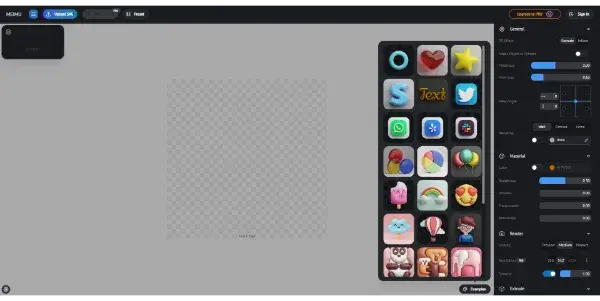Vector to 3D

A 3D effects generator that works from a vector image (SVG). Features numerous parameters: resolution, bevel, shadows, angles, etc.
Vector to 3D: Transforming 2D Designs into Stunning 3D Models
The world of digital design is constantly evolving, with new tools emerging to streamline workflows and unlock creative possibilities. Vector to 3D is a cutting-edge AI-powered tool that bridges the gap between 2D vector graphics and 3D models, offering a seamless and efficient way to bring your designs to life. This article explores its capabilities, applications, and how it stacks up against the competition.
What Vector to 3D Does
Vector to 3D is a sophisticated 3D effects generator that takes a vector image, typically in SVG (Scalable Vector Graphics) format, as input and transforms it into a realistic 3D model. This process eliminates the need for manual 3D modeling, significantly reducing time and effort involved in creating three-dimensional representations of your 2D designs. The tool leverages AI algorithms to intelligently interpret the vector data and generate a 3D model with impressive accuracy and detail.
Main Features and Benefits
Vector to 3D boasts a wide array of features designed to provide users with complete control over the 3D rendering process:
- Input Format: Accepts SVG files as input, ensuring compatibility with popular vector graphics editors.
- High Resolution Output: Generates 3D models at various resolutions, allowing for high-quality renders suitable for diverse applications.
- Extensive Parameter Control: Users have granular control over numerous parameters, including:
- Bevel: Adjust the sharpness or roundness of edges.
- Shadows: Control the intensity, angle, and softness of shadows for enhanced realism.
- Angles: Precisely manipulate the viewing angle and perspective of the 3D model.
- Lighting: Fine-tune lighting conditions to achieve desired aesthetics.
- Materials: (Potentially, depending on the tool's advanced features) Apply different materials to the 3D model, such as wood, metal, or plastic.
- Efficient Workflow: Automates the complex process of 3D modeling, saving valuable time and resources.
- AI-Powered Optimization: The AI algorithms ensure efficient processing and high-quality results.
Key Benefits:
- Time Savings: Significantly reduces the time required to create 3D models compared to traditional methods.
- Cost-Effectiveness: Eliminates the need for expensive 3D modeling software and expertise.
- Accessibility: Empowers designers with limited 3D modeling experience to create professional-looking 3D assets.
- High-Quality Results: Produces realistic and detailed 3D models with smooth surfaces and accurate representation of the original vector design.
Use Cases and Applications
The versatility of Vector to 3D makes it suitable for a wide range of applications across various industries:
- Product Design: Create realistic 3D prototypes of logos, packaging, and other design elements for visualization and client presentations.
- Game Development: Generate 3D assets for low-poly games, saving time and effort in the asset creation pipeline.
- Architectural Visualization: Create 3D models of building plans and designs for presentations and marketing materials.
- Marketing and Branding: Generate eye-catching 3D visuals for websites, social media, and advertising campaigns.
- Animation: Use the generated 3D models as assets in animations and short films.
Comparison to Similar Tools
While several tools offer 3D modeling capabilities, Vector to 3D distinguishes itself by its focus on vector input and AI-driven automation. Many competitive tools require more manual intervention or expertise in 3D modeling software. Vector to 3D offers a more user-friendly and efficient workflow for designers who are proficient with vector graphics but may lack extensive 3D modeling skills. A direct comparison would require identifying specific competitor tools and analyzing features side-by-side. Key differentiators to consider include ease of use, control over parameters, output quality, and pricing model.
Pricing Information
Vector to 3D operates on a freemium model. This means a basic version of the tool is available for free, offering a limited set of features and potentially watermarked outputs. A paid subscription unlocks advanced features, higher resolution outputs, and the removal of watermarks. Specific pricing details, including subscription tiers and features included in each tier, should be confirmed on the Vector to 3D official website.